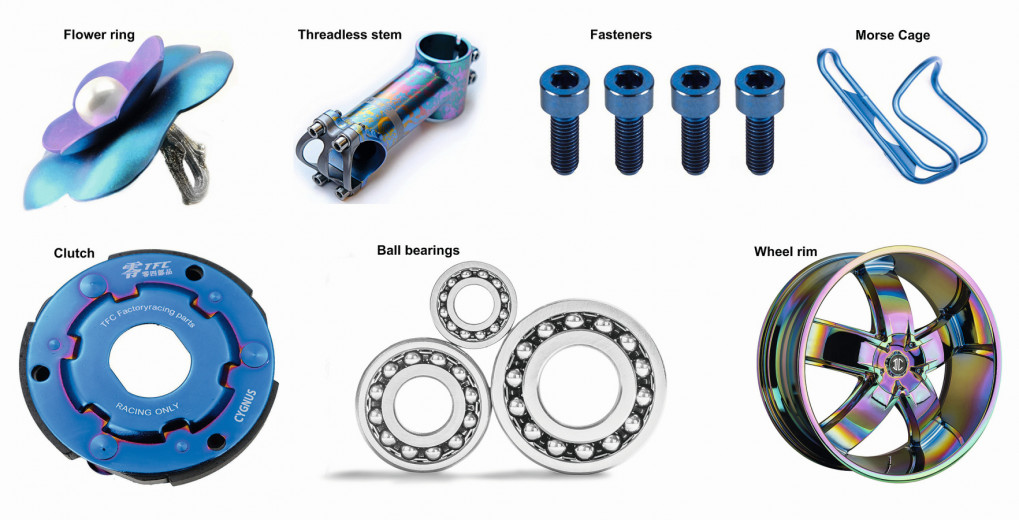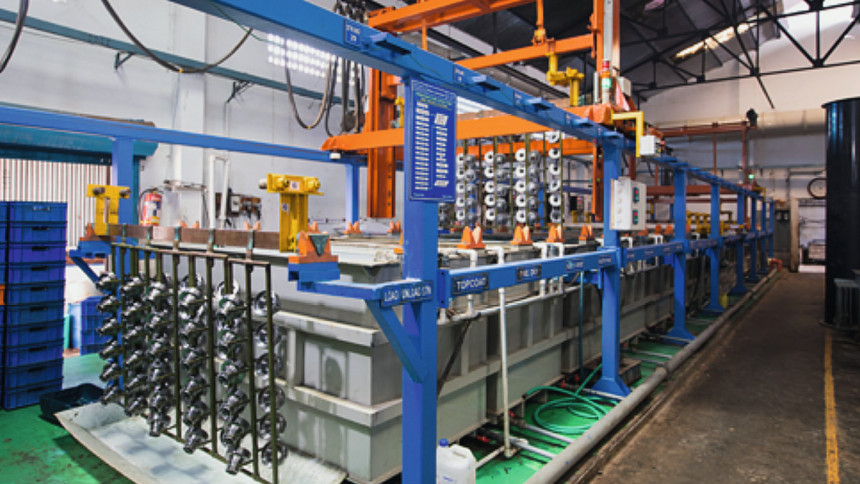Anodizing in Aqueous Electrolytes
The most common solutions employed for anodic oxidation of titanium include: 200 g/L sulfuric acid, 5 % trisodium phosphate, and 5 % sodium bicarbonate. A solution of 200 g/L sulfuric acid and 10 g/L oxalic acid produces parts with uniform colour. Sulphuric acid is, however, most extensively studied for oxidation of commercial titanium and Ti6Al-4V alloy [1–8]. A wide range of polarization conditions can be employed, including DC (direct current) and AC (alternating current). The process can be carried out either at constant current (galvanostatic process) or at constant voltage (potentiostatic process). Cathode material can be titanium (or inert material like Pt, graphite) with twice or more of the size of anode. Anodizing can be performed at room temperature, but the temperature of the anodizing solution should be controlled to ± 2 °C to obtain reproducible colours. A DC rectifier is widely used with an output of ~100 V and amperage based on the load size. Current densities of the order of ~ 2 A/dm2 are normally required. An image of a typical titanium anodizing plant is presented on the previous page, and finished anodized titanium parts are shown in Figure 1.
 Fig. 1: Anodized titanium parts
Fig. 1: Anodized titanium parts
A process of anodizing titanium for space applications is described by Sharma [1]. The following sequence of operations was adopted:
- ultrasonic solvent degreasing in methyl ethyl ketone for 5–10 minutes.
- electrolytic alkaline cleaning with mild job agitation for 5–7 minutes in a solution containing sodium hydroxide: 25 g/L, sodium metasilicate: 18 g/L, sodium carbonate: 16 g/L, disodium hydrogen orthophosphate: 9 g/L, sodium dodecyl sulphate: 0.5 g/L; anode: stainless steel; operating at 75–80 °C, 6–7 V. Water rinsing.
- acid pickling in a solution containing 150 ml/L nitric acid (70 %) and 10 ml/L hydrofluoric acid (40 %) for 1–2 minutes. Water rinsing.
- anodizing in a dilute sulphuric acid electrolyte as shown in Table 1, water rinsing, dip in hot water and air drying.
|
Sulphuric acid (s.g., 1.84) |
120–200 g/L (165) |
|
Temperature |
15–38 °C (23) |
|
Cathode |
Ti (or inert material like Pt, graphite) |
|
Voltage |
10–90 V (15) |
|
Electrolyte agitation |
By air (pressure, 40–60 kPa) |
|
Job agitation |
By anode rod movement (6 cm/sec.) |
|
Time |
4–5 minutes |
|
Appearance |
Coloured coatings |
|
Optimum conditions are shown in parentheses. |
|
Tab. 1: Anodizing bath formulation and operating conditions
The Physico-optical properties and colours produced on anodized titanium, depending on applied voltage, are given in Table 2. Figure 2 shows the SEM micrographs of Ti6Al4V surface, anodized in 1M H3PO4 + 0.5 wt% HF, at 20 V. The structure reveals the development of a well-defined, highly ordered nanoporous oxide layer [9]. The detailed SEM analysis shows that incremental change in the anodizing voltage leads to higher deposition rate of the oxide layer (or higher thickness) with increases in pore diameter [2]. Phase analysis revealed that with the progress of the anodization in sulphuric acid concentration of 0.4 M, the TiO2 formed successively transformed from anatase to rutile [2, 10].
![Fig. 2: SEM images of anodized titanium [9]](/images/stories/Abo-2023-08/gt-2023-08-099.jpg) Fig. 2: SEM images of anodized titanium [9]
Fig. 2: SEM images of anodized titanium [9]
|
Applied voltage (V) |
Colour |
Calculated Film Thickness (Å) |
αs (a) |
εIR (a) |
|
2 |
Silver |
– |
0.482 |
0.21 |
|
6 |
Light brown |
241 |
0.583 |
0.21 |
|
10 |
Golden brown |
362 |
0.657 |
0.21 |
|
15 |
Purple blue |
491 |
0.716 |
0.21 |
|
20 |
Dark blue |
586 |
0.738 |
0.21 |
|
25 |
Sky blue |
702 |
0.733 |
0.21 |
|
30 |
Pale blue |
815 |
0.714 |
0.21 |
|
35 |
Steel blue |
926 |
0.687 |
0.21 |
|
40 |
Light olive |
1036 |
0.659 |
0.21 |
|
45 |
Greenish yellow |
1147 |
0.670 |
0.22 |
|
50 |
Lemon yellow |
1246 |
0.647 |
0.21/0.22 |
|
55 |
Golden |
1319 |
0.664 |
0.22 |
|
60 |
Pink |
1410 |
0.663 |
0.22 |
|
65 |
Light purple |
1573 |
0.659 |
0.22 |
|
75 |
Blue |
1769 |
0.658 |
0.22 |
|
15 |
Silvery transparent (b) |
– |
0.486 |
0.21 |
|
(a) Average values in the entire solar or IR region. (b) Heat treated at 850 °C in vacuum. |
||||
Tab. 2: Physico-optical properties of anodic films of titanium [1]
Formation features of nanoporous titanium oxide structure under electrochemical anodizing by AC-DC current were investigated by Karabanov et al. [11]. Addition of AC-component (at the frequency of 100 Hz-10 kHz) leads to increase in coating formation rate and structure change in nanoporous TiO2 coatings: open intertubular space appeared, intertubular bridges formed and the nanotubes section became round.
Colour anodizing of Ti6Al4V alloy in 0.4 M phosphoric acid solution was performed at different voltages (10–120 V) by Karambakhsh et al. [12]. The colour was produced within 30 seconds. The effect of anodizing voltages on the colour and thickness of anodized layers was examined. The film thickness increased with increasing anodizing voltage and was in the range of 38–167 nm. The refractive index of anodic film was approximately constant at around 2 and increased insignificantly with increasing anodizing voltage. Corrosion resistance of the anodized samples in 20 V and 50 V was surveyed in artificial saliva solution, and Ringer’s solution + 150 mM H2O2 solution at 37 °C by potentiodynamic polarization. The anodized sample at 50 V indicated lower corrosion rate than the sample anodized at 20 V. These researchers have also compared the corrosion resistance of alkaline- and acid-anodized titanium [13].
Formation of Ca and P enriched anodic oxide film in calcium acetate and calcium glycerophosphate electrolyte for biomedical applications were reported [14, 15]. 5–7 µm thick oxide film with 0.98 µm Ra value and near 1.67 Ca/P ratio was fabricated by anodization in 0.02 M calcium glycerophosphate and 0.15 M calcium acetate electrolyte in galvanostatic mode (0.7 A/dm2, final voltageca. 350 V) [15].
Titanium oxide nanotubes (TNT), and nanotube arrays have been produced by a variety of methods, including deposition into nano porous alumina template, sol-gel transcription using organo-gelators as templates, seeded growth, hydrothermal processes, etc. However, the best results with precise control of the dimensions of highly ordered nanotube arrays can be achieved by anodization of titanium in fluoride-based baths with well-defined conditions (electrolyte, potential applied, time, etc.). Different types of highly ordered TiO2 structures such as nanowires, nanorods, nanotubes, nanofilms, can be produced. Fabrication of TiO2 nanotube arrays via anodic oxidation of titanium foil in a fluoride-based electrolyte solution was first reported in 2001 by Gong et al. [16]. Various fluoride-containing electrolytes (NH4F/CH3COOH, H2SO4/HF, Na2HPO4/NaF) can be used [17]. The current density used in fluoride-containing electrolytes is higher than those in fluoride-free electrolytes, and it increased with increasing the fluoride content in the range of 0–2 wt%.
Anodizing in Organic Electrolytes
Anodization to form tube layers is usually carried out by applying a potential step (or ramp) at a constant voltage between 1–30 V in aqueous electrolyte or 5–150 V in nonaqueous electrolytes. Use of organic electrolyte systems, such as ethylene glycol, ethanol, mixed ethanol and ethylene glycol, dimethyl sulfoxide (DMSO) electrolytes containing approximately 0.05m–0.5m (0.1–1 wt%) fluoride ions (usually with some background ion species) are recommended [18–26]. Much lower current densities are observed in the organic electrolytes in comparison of aqueous solutions, which is attributed to higher diffusibility and concentration of ions in aqueous electrolytes.
Zhou and his co-workers [22] reported the formation of dense anodic titanium dioxide nanotubes in ethylene glycol, ethanol and mixed ethanol and ethylene glycol electrolytes containing 0.7 wt% NH4F and 1.8 vol% H2O under different voltages (40, 50 and 60 V) at 25 °C for 300 seconds. The presence of fluoride ions at these levels ensures the equilibrium between the formation of titanium oxide nanotubes at the metal-oxide interface and the dissolution of TiO2 at the oxide-electrolyte interface [27]. Almost ideal hexagonally arranged TiO2 tube layers can be grown to a thickness of several hundred microns.
Anodizing in Deep Eutectic Solvents
Deep Eutectic Solvents (DESs) can be used as a green alternative to conventional electrolytes [28]. DES refers to solutions of Lewis or Bronsted acid and bases which form a eutectic mixture i.e., the molar ratio of the components which gives the lowest melting point. DESs are represented by the general formula Cat+ X–zY. where Cat+ is in principle any ammonium, phosphonium, or sulfonium cation, and X is a Lewis base, generally a halide anion. The complex anionic species are formed between X– and either a Lewis or Bronsted acid Y (z refers to the number of Y molecules that interact with the anion). The majority of studies have focused on quaternary ammonium and imidazolium cations with particular emphasis being placed on more practical systems using choline chloride, [ChCl, HOC2H4N+(CH3)3Cl–] [29].
While anodizing titanium in NH4F-glycerol electrolyte, Chen et al. [30] in their studies showed that the addition of DES (1: 1 molar ratio of succinic acid and choline chloride) to electrolyte results in the formation of TiO2 nano bamboos (NBs), with periodic exterior rings. Anodizing on Grade 2 titanium with DES solvent was investigated by Winiarski and co-workers [31, 32]. DES bath was prepared by mixing the choline dihydrogen citrate salt with oxalic acid dihydrate in 1: 1 molar ratio. Anodic polarization was carried out at a constant voltage of 10–30 V for 10 minutes at 60 °C. Titanium anodized at the lowest applied voltage (10 V) had a deep yellow colour, which turned to deep blue at 30 V. Anodizing at 10 V produced a fine granular morphology, while anodizing at 30 V led to the formation of a thicker and quite uneven oxide layer, characterized by a distinct and coarse granular morphology. Anodizing in DES baths produces a homogeneous layer whose thickness at a potential of 10 V exceeds 10 nm in just a few seconds. The potentiodynamic polarization studies showed that the DES bath anodized film exhibited at least one order of magnitude greater corrosion resistance compared to bare titanium substrate.
Kityk et al. [33] studied galvanostatic electrochemical treatment of Ti6Al4V alloy in a deep eutectic solvent Ethaline (a eutectic mixture of choline chloride and ethylene glycol in molar ratio 1:2, respectively) at 25 °C. A short-time anodic treatment in Ethaline with a wide range of current densities (0.2–5.0 A/dm2) led to formation of surface oxide films with controllable chemical composition, roughness and wettability, improved corrosion resistance with biologically-inspired topography. The formation of microrough structure on surfaces was observed at low current densities (0.2-1.5 A/dm2), and nanorough structure at higher current densities (2-5 A/dm2). The treated samples had good cell adhesion and cell viabilities and did not demonstrate any cytotoxic effect. Bacterial resistance of Ti6Al4V alloy samples can be controllably adjusted and increased by the surface leveling in Ethaline at high current densities.
Factors Influencing the Anodizing Process
Anodizing is an electrochemical conversion coating process; the substrate material primarily determines the composition and the properties of the anodic oxide film. In addition, the nature of electrolyte, processing temperature and electrical regimes employed influence the process of coating formation and its characteristics. By altering some synthesis variables, the morphology and structural properties of anodic TiO2 nanotube arrays can be tailored to a specific application [34]. Influence of anodization parameters on the formation of TiO2 nanotubes (TNT), tube dimensions, formation mechanism, properties and their applications in the biomedical field are reviewed by Indira et al. [35].
Nature of Electrolyte
The nature of electrolyte strongly influences the formation of the graded TNT structure. Under the same operating conditions, different electrolytes may produce different electric field intensities. Further, in the initial stage of anodization, the higher electric field intensity can induce bigger breakdown sites which finally result in wider diameter of TNTs. Additionally, the chemical dissolution rate of the oxide layer is also discrepant in different electrolytes. In other words, one can obtain different titanium oxide structures such as a flat compact oxide, a disordered porous layer, a highly self-organized porous layer, and/or a highly self-organized nanotubular layer by controlling the electrochemical anodization parameters for specific applications [36].
Electrolyte pH
The electrolyte pH plays a key role in achieving the growth of the high-aspect ratio and self-organization behaviour of TNT. The difference in the pH leads to significant variations in the pore diameter. The differences in thickness are attributed to pH dependence of the oxide dissolution rate, i.e., dissolution rate at low pH is much greater than the higher pH [37]. Macak and co-workers [38] used a highly viscous glycerol electrolyte that suppresses local concentration fluctuations and changes in pH during the anodization of titanium. This leads to layers of smooth TiO2 nanotubes up to 7 μm thick and with an average pore diameter of 40 nm.
Processing Temperature
The processing temperature of electrolyte influences the growth and morphology of anodically produced self-organized titanium oxide nanotubes [39]. Self-organized nanotubes are formed in glycerol electrolyte at temperatures of 0, 20, and 40 °C. At above 40 °C, unstable bundles of tubes are produced on the Ti surface [38]. Due to the slower etching rate of the oxide layer, no regular pores were formed at lower temperatures [38, 39].
Electrical Parameters
The applied current densities impact the characteristics of the resultant TNTs. Different current densities produce different pore sizes, which affect the electrochemical etching rate. As the current density increases, the electrochemical etching rate, power, and electric field intensity also surge. These effects appear to cause pit widening before the formation of channels, which form separate pores. With increase in the current density the pore size of TNT increases. Consequently, different tube diameters could be produced by controlling the current density [36]. The current density in fluoride-containing electrolytes is higher than those in fluoride-free electrolytes, and increases with increasing the fluoride content in the range of 0–2 wt%
Processing Time
The anodizing duration affects the TNT formation mechanism. According to Li et al. [40], the minimum time needed for the formation of TNT is around 15 minutes, with an increase in time highly ordered TNT can be formed. Regonini and Clemens [41] reported that for an anodization time of ~5 minutes, only nanoporous structure is formed, but after 10–20 minutes, the nanotubular structure becomes clearly visible. A short and narrow TNT can be obtained in short growth time (5 minutes) [42].
Annealing
The TNTs produced after anodization are amorphous and not photoactive. Therefore, it is necessary to transform the amorphous TNTs into crystalline form for an array of applications. High temperature calcination (300 to 600 °C) is regarded as an effective route to enhance crystallization converting into anatase or rutile phase [43, 44].
REFERENCES
[1] A.K. Sharma: Anodizing titanium for space applications, Thin Solid Films, 208(1992)1, 48–54, doi: 10.1016/0040-6090(92)90946-9
[2] K.-H. Kim; N. Ramaswamy: Electrochemical surface modification of titanium in dentistry, Dent. Mater. J., 28(2009)1, 20–36, doi: 10.4012/dmj.28.20
[3] J.L. Delplancke; R. Winand: Galvanostatic anodization of titanium-I. Structures and compositions of the anodic films, Electrochim. Acta, 33(1988)11, 1539–1549, doi: 10.1016/0013-4686(88)80223-8
[4] B. Liang; S. Fujibayashi; M. Leo; J. Tamura; H.M. Kim; M. Uchida; T. Kokubo; T. Nakamura: Histological and mechanical investigation of the bone-bonding ability of anodically oxidized titanium in rabbits, Biomater., 24(2003)27, 4959–4966, doi: 10.1016/S0142-9612(03)00421-6
[5] N. Masahashi; Y. Mizukoshi; S. Semboshi; N. Ohtsu: Enhanced photocatalytic activity of rutile TiO2 prepared by anodic oxidation in a high concentration sulfuric acid electrolyte, Appl. Catal. B, 90(2009)1-2, 255–261,
doi: 10.1016/j.apcatb.2009.03.011
[6] M. Manjaiah; R.F. Laubscher: Effect of anodizing on surface integrity of Grade 4 titanium for biomedical applications, Surf. Coat. Technol., 310(2017), 263–272, doi: 10.1016/j.surfcoat.2016.12.038
[7] M.L. Vera; A. Colaccio; M.R. Rosenberger; C.E. Schvezov; A.E. Ares: Influence of the electrolyte concentration on the smooth TiO2 anodic coatings on Ti-6Al-4V, Coatings, 7(2017)3, 39, doi: 10.3339/coatings7030039
[8] A. Kumar: Anodization of titanium alloy (Grade 5) to obtain nanoporous surface using sulfuric acid electrolyte, IETE J. Res., (2020), doi: 10.1080/03772063.2020.1780958
[9] G. Strnad; C. Petrovan; O. Russu; L. Jakab-Farkas: TiO2 nanostructured surfaces for biomedical applications developed by electrochemical anodization, IOP Conf. Ser.: Mater. Sci. Eng., 161(2016)1, 012051, doi:10.1088/1757-899X/161/1/012051
[10] Y. Mizukoshi; N. Ohtsu; N. Masahashi: Structural and characteristic variation of anodic oxide on pure Ti with anodization duration, Appl. Surf. Sci., 283(2013), 1018–1023, doi: 10.1016/j.apsusc.2013.07.062
[11] S.M. Karabanov; D.V. Suvorov; G.P. Gololobov; Y. M. Stryuchkova; M. A. Klyagina; E.V. Slivkinl: The features of TiO2 films structure formation under conditions of electrochemical anodizing by direct current with variable component application, MRS Adv., 1(2016)46, 3127–3131, doi: 10.1557/adv.2016.265
[12] A. Karambakhsh; A. Afshar; P. Malekinejad: Corrosion Resistance and Color Properties of Anodized Ti-6Al-4V, J. Mater. Eng. Perform., 21(2012), 121–127, doi: 10.1007/s11665-010-9791-1
[13] A. Karambakhsh; S. Ghahramani; A. Afshar; P. Malekinejad: Comparison of the corrosion resistance of alkaline- and acid-anodized titanium, Mater. Perform., 54(2015)1, 51–55
[14] X. Zhu, K.H. Kim, Y. Jeong: Anodic oxide films containing Ca and P of titanium biomaterial, Biomater., 22(2001)16, 2199–2206, doi: 10.1016/s0142-9612(00)00394-x
[15] W.W. Son; X. Zhu; H.I. Shin; J.L. Ong; K.H. Kim: In vivo histological response to anodized and anodized/ hydrothermally treated titanium implants, J. Biomed. Mat. Res.- B, 66(2003)2, 520–525, doi: 10.1002/jbm.b.10042
[16] D.W. Gong; C.A. Grimes; O.K. Varghese; W. Hu; R.S. Singh; Z. Chin; Dickey E.C.: Titanium oxide nanotube arrays prepared by anodic oxidation, J. Mater. Res., 16(2001), 3331–3334, doi: 10.1557/jmr.2001.0457
[17] D.-J. Yang; H.-G. Kim; S.-J. Cho; W.-Y. Choi: Thickness-conversion ratio from titanium to TiO2 nanotubes fabricated by anodization method, Mater. Lett., 62(2008)4-5, 775–779, doi: 10.1016/j.matlet.2007.06.058
[18] H.Y. Hwang; A.A. Prabu; D.Y. Kim; K.J. Kim: Influence of the organic electrolyte and anodization conditions on the preparation of well-aligned TiO2 nanotube arrays in dye-sensitized solar cells, Sol. Energy, 85(2011)7, 1551–1559, doi: 10.1016/j.solener.2011.04.017
[19] K.A. Lopez-Jaime, D.Y. Penna-Ballesteros, A. Sandoval-Amador: Characterization of titanium oxide nanotubes growth through anodization in organic solvents, J. Phys.: Conf. Ser., 1386(2019)1, 012009, doi: 10.1088/1742-6596/1386/1/012009
[20] O. Rodríguez-Martínez; L.M. Martínez; M. Videa: Electropolishing and anodization of titanium in water/ethylene glycol baths for the production of TiO2 nanotubes. J. Nanopart. Res., 22(2020)119, doi: 10.1007/s11051-020-04824-8
[21] I.P. Torres-Avila; I.I. Padilla-Martínez; N. Perez-Hernandez; Banuelos- A.E. Hernandez; J.C. Velazquez; J.L. Castrejon-Flores; E. Hernandez-Sanchez: Surface Modification of the Ti-6Al-4V Alloy by Anodic Oxidation and Its Effect on Osteoarticular Cell Proliferation, Coatings,10(2020)5, 491, doi: 10.3390/coatings10050491
[22] Q. Zhou; M. Tian; Z. Ying; Y. Dan; F. Tang; J. Zhang; J. Zhu; X. Zhu: Dense films formed during Ti anodization in NH4F electrolyte: Evidence against the field-assisted dissolution reactions of fluoride ions, Electrochem. Commun., 111(2020), 106663, doi: 10.1016/j.elecom.2020.106663
[23] M. Zhang; J. Gao; X. Huang; Y. Ma; B. Zhou; Z. Liu; Y. Xue; S. Yu; Y. Wu: Anodic growth of Ta-Ti-O nanotube arrays on Ta/Ti6Al4V alloy layer, Mater. Charact., 182(2021), 111572, doi: 10.1016/j.matchar.2021.111572
[24] M. Michalska-Domanska; M. Czerwinski; M. Lazinska; V. Dubey; M. Jakubaszek; Z. Zawadzki; J. Kostecki: Morphological and Optical Characterization of Colored Nanotubular Anodic Titanium Oxide Made in an Ethanol-Based Electrolyte, Materials, 14(2021)22, 6992, doi: 10.3390/ma14226992
[25] X. Li; C. Li; T. Gong; J. Su; W. Zhang; Y. Song; X. Zhu: Comparative study on the anodizing process of Ti and Zr and oxide morphology, Ceram. Int., 47(2021)16, 23332–23337, doi: 10.1016/j.ceramint.2021.05.046
[26] P. Nakpan; A. Aeimbhu: Fabrication of titanium dioxide nanotubes by difference the anodization voltage and time, Materials Today: Proc., 47(2021)1, 3436–3440, doi: 10.1016/j.matpr.2021.03.290
[27] Reza M., Naghizadeh, M., Abdizadeh, H.: Effect of fluoride concentration and water content on morphology of titania nanotubes in ethylene glycol solution, Adv. Mater. Res., 829(2013), 907–911,
doi: 10.4028/www.scientific.net/AMR.829.907[28]G. Li; K. H. Row: Utilization of deep eutectic solvents in dispersive liquid-liquid micro-extraction, TrAC, Trends Anal. Chem., 120(2019), 115651, doi: 10.1016/j.trac.2019.115651
[29] E.L. Smith; A.P. Abbott; K.S. Ryder: Deep Eutectic Solvents (DESs) and their applications, Chem. Rev., 114(2014)21, 11060–11082, doi: 10.1021/cr300162p
[30] C.Y. Chen; K. Ozasa; F. Kitamura; K.-I. Katsumata; M. Maeda; K. Okada; N. Matsushita: Self-organization of TiO2 Nanobamboos by Anodization with Deep Eutectic Solvent, Electrochim. Acta, 153(2015), 409-415, 10.1016/j.electacta.2014.11.084
[31] J. Winiarski; A. Niciejewska; M. Gornik; J, Jakubowski; W, Tylus; B. Szczygiet: Titanium anodizing in a choline dihydrogencitrate salt-oxalic acid deep eutectic solvent: a step towards green chemistry in surface finishing of titanium and its alloys, RSC Adv., 11(2021)34, 21104–21115, doi: 10.1039/d1ra01655e
[32] J. Winiarski; W. Tylus; M. Pawlyta; B. Szczygiel: Titanium anodization in deep eutectic solvents: The effect of anodizing time on the morphology and structure of anodic layers, Appl. Surf. Sci., 577(2021), 151892, doi: 10.1016/j.apsusc.2021.151892
[33] A. Kityk; V. Protsenko; F. Danilov; L. Bobrova; M. Hnatko; V. Pavlik; J. Soltys; M. Labudova; M. Ruskova; D. Pangallo: Design of Ti-6Al-4V alloy surface properties by galvanostatic electrochemical treatment in a deep eutectic solvent Ethaline, Surf. Coat. Technol., 429(2021), 127936, doi: 10.1016/j.surfcoat.2021.127936
[34] A.P. Simon; A. Rodrigues; J.S. Santos; F. Trivinho-Strixino; B.L. Pereira; C.M. Lepienski; H.E.Z. Junior; M.D.S. Sikora: TiO2 NTs bio-inspired coatings: Revisiting electrochemical, morphological, structural, and mechanical properties, Nanotechnology, 33(2022)28, 025706, doi: 10.1088/1361-6528/ac2b6b
[35] K. Indira; U. Kamachi Mudali; T. Nishimura; N. Rajendran: A review on TiO2 nanotubes: Influence of anodization parameters, formation mechanism, properties, corrosion behavior, and biomedical applications, J Bio Tribo Corros, 1(2015)28, 1–22, doi: 10.1007/s40735-015-0024-x
[36] L.V. Taveira; J.M. Macak; H. Tsuchiya; L.F.P. Dick, P. Schmuki: Initiation and growth of self-organised TiO2 nanotubes anodically formed in NH4F/(NH4)2SO4 electrolytes, J. Electrochem. Soc., 152(2005)10, B405-B410, doi: 10.1149/1.2008980
[37] J.M. Macak; K. Sirotna; P. Schmuki: Self-organised porous titanium oxide prepared in Na2SO4/NaF electrolytes,
Electrochim. Acta, 50(2005)18, 3679–3684, doi: 10.1016/j.electacta.2005.01.014
[38] J.M. Macak; H. Tsuchiya; L. Taveira; S. Aldabergerova; P. Schmuki: Smooth anodic TiO2 nanotubes, Angew. Chem. Int. Ed., 44(2005)45, 7463–7465, doi: 10.1002/anie.200502781
[39] T. Ghani; M. Mujahid; M. Mehmood; M. Ubaidullah; A. Shah, A. Mahmood: Effect of processing temperature on the morphology and crystal structure of anodic TiO2 nanotubes, J. Electron. Mater., 49(2020)3, 1881–1888, doi: 10.1007/s11664-019-07864-6
[40] Y. Li; Q. Ma; J. Han; L. Ji; J. Wang; J. Chen; Y. Wang: Controlled preparation, growth mechanism and properties research of TiO2 nanotube arrays, Appl. Surf. Sci., 297(2014), 103–108, doi: 10.1016/j.apsusc.2014.01.086
[41] D. Regonini; F.J. Clemens: Anodized TiO2 nanotubes: effect of anodizing time on film length, morphology and photo electrochemical properties, Mater, Lett., 142(2015), 97–101, doi: 10.1016/j.matlet.2014.11.145
[42] X. Wen; M. Cao; J. Wu; J. Tao; Y. Sun; N. Dai: Morphology dependence of TiO2 nanotube arrays on anodization variables and buffer medium, J. Semicond., 31(2010)6, 063003, 1–5, doi: 10.1088/1674-4926/31/6/063003
[43] J. Yu; B. Wang: Effect of calcination temperature on morphology and photoelectrochemical properties of anodized titanium dioxide nanotube arrays, Appl. Catal. B, 94(2010)3-4, 295–302, doi: 10.1016/j.apcatb.2009.12.003
[44] H. Tsuchiya; J.M. Macak; A. Ghicov; A.S. Rader; L. Taveira; P. Schmuki: Characterization of electronic properties of TiO2 nanotube films, Corros. Sci., 49(2007)1, 203–210, doi: 10.1016/j.corsci.2006.05.009













